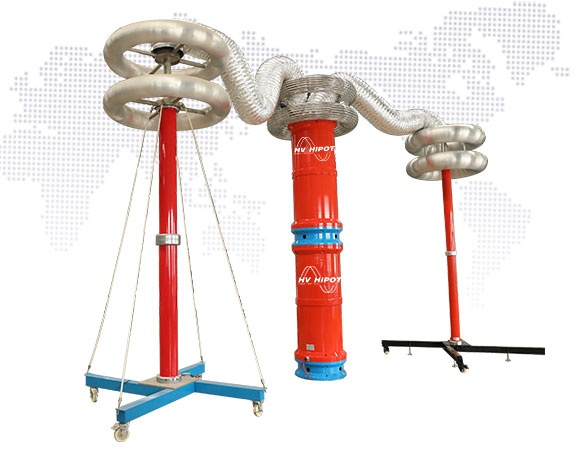The frequency AC resonant test system is used to identify the insulation strength of electrical equipment. It is of decisive significance for judging whether the electrical equipment can be put into operation. It is also an important means to ensure the insulation level of the equipment and avoid insulation accidents. Because the frequency conversion series resonance test device can fully reflect the actual situation of electrical equipment operating under AC voltage, it can truly and effectively find insulation defects.

HV HIPOT GDTF series Frequency Conversion AC Resonant Test System
Due to the resonance principle adopted by the frequency conversion series resonance test device, the voltage of a certain frequency in the system loop and the capacitance and reactance in the loop generate resonance. The voltage across the capacitor reaches the test voltage.
According to the above principles and the actual test situation on site, the overvoltage of the frequency conversion series resonance generally occurs in two situations, one is when the instrument is searching for the resonance point and the process of generating the resonance voltage; the other is when the boost voltage reaches the test voltage. in the case of.
In the case of finding the resonance point in series resonance and boosting it to the test voltage, generally in the case that the withstand voltage of the test product is unqualified or the site environment has not undergone major changes, the test will not produce overvoltage protection or other faults. However, since the grid voltage is not constant and the input voltage of the power supply fluctuates, the high-voltage output also has a certain volatility, which may cause overvoltage protection on the voltage peak. If the power supply voltage fluctuates, you can adjust the overvoltage protection of the instrument, and set the overvoltage protection to a relatively high value. We generally require the overvoltage protection to be set to 1.1-1.2 times the voltage protection. At this time, it is basically no problem to set it to 1.2 times.
The above is a simple problem, but it is difficult for voltage fluctuations to cause overvoltage to occur when overvoltage protection is set up. Generally, the overvoltage of the frequency conversion series resonance test device is in the frequency sweep stage of the instrument, that is, in the process of finding the resonance point. Anyone who has used the frequency conversion series resonance test device knows that in the process of finding the resonance point of the frequency conversion series resonance test device, the voltage and frequency have the same linear relationship as a parabola. By default, the system finds the higher voltage, that is, the vertex of the parabola, as the resonance point. Since the theory of resonance principle can resonate the low-voltage voltage to 80 times (due to the quality factor and other relations generally not more than 30 times), the voltage required for frequency sweeping of the frequency conversion series resonance test device is generally 20-50V, and the voltage after excitation is generally for several hundred volts. Through the above principles, we found that if the test voltage of the test product we need is lower than the voltage when the system resonance is the resonance point, the system may have overvoltage protection when it automatically searches for the resonance point. At this time, the entire variable frequency series resonance test device cannot withstand the pressure, the test could not be completed.
The solution to this problem is also relatively troublesome. It is not that the variable frequency series resonance test device cannot generate the test voltage, but the resonance voltage is higher than the test voltage. We know that the default resonance voltage of the system is the vertex of the parabola, that is to say, when the parabola rises to In the process of vertex or vertex descending, there will be a point that is consistent with the test voltage point. We only need to test the manual test of frequency conversion series resonance, and use manual frequency search to find the frequency point consistent with the voltage used and then withstand the voltage to solve the overvoltage problem in the process of finding the resonance point.
Post time: Jun-14-2022
